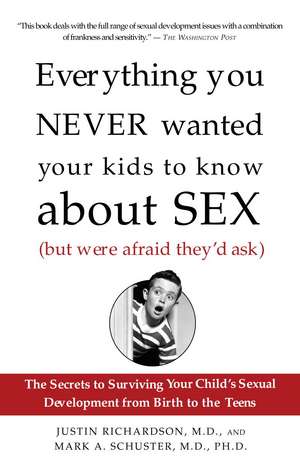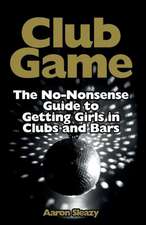Everything You Never Wanted Your Kids to Know about Sex (But Were Afraid They'd Ask): The Secrets to Surviving Your Child's Sexual Development from Bi
Autor Justin Richardson, Mark Schusteren Limba Engleză Paperback – 29 feb 2004
• What to expect at each stage of your child’s development and how you can influence it from birth onward
• What to tell your kids at every age about sex and how to get the conversation going
• What to do when your five-year-old turns up naked with the girl next door, your toddler is rubbing on her teddy bear, or your six-year-old walks in on you having sex
• How to avoid unnecessary clashes with your middle-schooler while managing privacy, crushes, and what to wear
• How to encourage your teenager to use contraception without encouraging her to have sex, and how to help her choose the method that’s best for her
Preț: 121.82 lei
Nou
Puncte Express: 183
Preț estimativ în valută:
23.31€ • 25.31$ • 19.58£
23.31€ • 25.31$ • 19.58£
Carte disponibilă
Livrare economică 02-16 aprilie
Preluare comenzi: 021 569.72.76
Specificații
ISBN-13: 9781400051281
ISBN-10: 1400051282
Pagini: 448
Dimensiuni: 132 x 203 x 23 mm
Greutate: 0.45 kg
Ediția:Pbk.
Editura: HARMONY
ISBN-10: 1400051282
Pagini: 448
Dimensiuni: 132 x 203 x 23 mm
Greutate: 0.45 kg
Ediția:Pbk.
Editura: HARMONY
Recenzii
“A wonderfully sophisticated set of answers to the questions that make even the most confident of parents squirm! These two experts have crafted the essential guide to managing the vast array of challenges involving kids and sex. Simultaneously wise and funny, this highly accessible book will help parents safely through what might otherwise seem like a thicket of anxiety and confusion. A must-read for every thoughtful and caring parent.”
—William Pollack, author of Real Boys and codirector of the Center for Men at McLean Hospital, Harvard Medical Center
“A comprehensive and factual resource on a very delicate subject presented in a humorous and entertaining style. The authors cover all the bases, but do so with a light and sensitive touch. I would not hesitate to recommend this book to the parents of my patients.”
—Joe M. Sanders, M.D., executive director of the American Academy of Pediatrics
“I wished I had asked these questions. A sensitive and intelligent look at sexuality written with candor and creativity, this book will open the discussion for all the important issues.” —Wendy Wasserstein, author of Shiksa Goddess and The Heidi Chronicles
“In their warm, non-judgmental way, Justin Richardson and Mark Schuster guide us through our children's sexual development with the perfect mix of humor, wisdom, and straightforward information. I highly recommend this book for every parent.”
—Ruth Bell, coauthor of Changing Bodies, Changing Lives
From the Hardcover edition.
—William Pollack, author of Real Boys and codirector of the Center for Men at McLean Hospital, Harvard Medical Center
“A comprehensive and factual resource on a very delicate subject presented in a humorous and entertaining style. The authors cover all the bases, but do so with a light and sensitive touch. I would not hesitate to recommend this book to the parents of my patients.”
—Joe M. Sanders, M.D., executive director of the American Academy of Pediatrics
“I wished I had asked these questions. A sensitive and intelligent look at sexuality written with candor and creativity, this book will open the discussion for all the important issues.” —Wendy Wasserstein, author of Shiksa Goddess and The Heidi Chronicles
“In their warm, non-judgmental way, Justin Richardson and Mark Schuster guide us through our children's sexual development with the perfect mix of humor, wisdom, and straightforward information. I highly recommend this book for every parent.”
—Ruth Bell, coauthor of Changing Bodies, Changing Lives
From the Hardcover edition.
Notă biografică
JUSTIN RICHARDSON, M.D., is an assistant professor of psychiatry at Columbia and Cornell universities and a well-known authority on kids and sex.
MARK A. SCHUSTER, M.D., PH.D., is an associate professor of pediatrics and public health at UCLA,
codirector of the Center for Child and Adolescent Health Research at RAND, and director of the UCLA/RAND Center for Adolescent Health Promotion.
From the Hardcover edition.
MARK A. SCHUSTER, M.D., PH.D., is an associate professor of pediatrics and public health at UCLA,
codirector of the Center for Child and Adolescent Health Research at RAND, and director of the UCLA/RAND Center for Adolescent Health Promotion.
From the Hardcover edition.
Extras
Chapter 1
How did this happen?
The natural history of your child's sexuality
You are flat on your back. Your shirt is pulled up over your belly, and your pants are down around your hips. Someone has just squirted a glob of cold jelly below your navel. This is one of those miraculous moments in life that doesn't always live up to its billing in terms of physical comfort. The ultrasound.
Your main concern is whether the baby will be normal. But you are hoping for a little fun. "I want to see a face," you say, craning up from the table. And you want to know if it's a girl or a boy. The last time they said they couldn't be sure.
The radiologist starts sliding the probe over your belly.
"There's the head."
"The head? Where?" She bends the monitor in your direction.
"See, right here."
You see something that looks like a blizzard being broadcast on a 1969 Magnavox.
"Where?" (Is she pressing harder?)
"Here, right here, see that?"
She is definitely pressing harder. You consider humoring her. Then a ghostly face appears in the snow. It is tiny, but it is a face. You can make out a delicate profile: an eye, and a nose, and cupped up near its open mouth, a tiny . . . something.
A burger?
"That's its left hand."
A left hand! The baby looks so sweet and tranquil, as if it's asleep. A sleeping angel. A staticky sleeping angel.
"It's a boy."
You are now in a new part of the blizzard.
"Are you sure?"
"Pretty sure. See, here? Between the legs?" Now she is pressing with real excitement.
"Oh yeah, those are legs. I definitely see them."
"Well, if you look right between them, you can just make it out."
"Make what out?"
"His penis. You see? He's got an erection."
"A what?"
An erection.
Your Child Is Already Sexual
We know two things about children's sexual development: Children learn about sex from the world. And children are inherently sexual.
We have all easily accepted the first idea. The second one gives us a little more trouble.
At least since the Enlightenment days of John Locke, the idea of a child as a blank slate scribbled on by the world has been a favorite. Nowhere has this idea held more sway than in the area of sexuality: We like to think our children are born without it.
A hundred years ago, the Victorians, who perfected the idea of the innocent child, made a science out of sheltering children from knowledge about sex, going so far as to clothe suggestively nude piano legs with ruffled skirts. Children were innocents. Adults were sexual. If children became sexual, it must be through the influence of adults. Just as we worry about the effects of the Internet today, Victorian heads of household feared the nursemaid might kindle randy thoughts in their children while Mother and Father were away.
Little wonder the world considered Freud's theories of the inherent sexuality of children about as welcome as salmonella at a state dinner.
We have learned a lot about the sexual development of children since Freud first alarmed our ancestors. Many of the specifics within his theory have been discarded. But the core of his heretical idea remains. Sexuality, we understand, develops naturally in all children. Its seeds can be found in infants, and it unfolds into mature sexual feeling in children as they grow, whether we tell them what it all means or remain resolutely silent.
How does this happen? How does an erection on an ultrasound evolve into the complex mating ritual practiced in a school stairwell by a nervous eleventh grader and his best friend's girlfriend's sister?
We are going to answer this question in a moment, to the extent that it's possible, by walking you through the sexual development of one girl and one boy. By the time these two are approaching adulthood, you will have learned all you need to know about the way a child becomes sexual. Throughout the book, we will revisit each of the issues these two lives raise. But before we start inspecting those particular trees, we want you to have a clear view of the forest.
As you will soon discover, sexuality isn't created in a child by her first sex education class. Nor is it turned on by a single hormonal switch that gets flipped at puberty. Instead, try thinking of sexuality as something assembled by each developing child over a period of years out of component parts. Some of the components a child will use for this job are on hand at birth, such as her genitals. When you get a baby girl, the vulva is included, and even before she can speak she will discover that touching her genitals feels good. It looks like there's something sexual about that act, but full-fledged sexuality requires more than sensitive genitals.
With time, this element will connect with other elements not available during infancy. Fantasies of being close to another person may come along several years later. When they do, a child will find that having these fantasies makes her genitals especially sensitive. The pleasure of touching them increases, and from then on, that pleasure is linked with thoughts of being with other people. Now something that resembles our grown-up image of sexuality is beginning to take shape.
In every child's life, several basic elements will grow and combine to form her nascent sexuality. Consider them sexuality's wheels and gears. They are:
*Spontaneous genital arousals
*Pleasurable genital self-stimulation
*Exploratory "sex play" with peers
*Attractions to others
*Fantasies of sex
*The ever-maturing ability to love
To make a long story very, very short: Over the course of a childhood, arousals that were once spontaneous start being cued by attractions to people. Arousing attractions then get linked to fantasies of sexual behavior. And when fantasies stimulate sexual experimentation with peers, an adultlike sexuality is born-at an age young enough to make the average parent gasp.
Obviously, someone needs to learn how to drive this thing. And so, as she is assembling these components, a child will also be developing the intellectual understanding, the moral structure, and the psychological maturity necessary to steer her burgeoning sexuality.
Whatever her childhood experiences, whether she's raised at a nudist colony or learns to sound out the word abstinence in preschool, every child will fashion and refashion some kind of working sexual scooter as she grows. Of course, how it is assembled and how it looks will differ depending on her particular temperament and life experiences. As you may know from your own experience, your child's sexuality will be added to and altered throughout her life. Sexual development never ends.
But we are getting ahead of ourselves.
Let's take a visit to a sleepy community hospital where, side by side in the nursery, are two infants, one a wriggly little newborn-a girl-and one a tiny bald boy, silently sleeping.
Welcome Eloise and Max.
Infants and Toddlers (Birth to Age Two)
Max is born with all the equipment a little boy needs. Before he leaves the hospital, something alarming will be done to his penis. Eloise, who is born with all the equipment a little girl needs, will not suffer any such surprise. They are bundled up and swept off to their new homes. Once there, they will get a lot of action going simply by crying. That action will include a good deal of diapering.
As with other newborns, at diaper time Eloise's and Max's parents may be able to observe that they have spontaneous arousals. Max will develop an erection. Eloise-although it will be much harder to see-will lubricate. It is unclear what causes these arousals at this age, whether they are responses to physical stimulation or to an internal signal in the baby's mind or body. Some consider these arousals a kind of reflex. They represent the earliest functioning after birth of a child's sexual apparatus.
Being held and caressed are among the greatest pleasures of infant life. So is having your chin stroked and your back rubbed. And so is playing with your genitals. In her eighth month, Eloise coos when her diaper is changed if she feels a breeze on her labia. Max, at ten months, likes to play with his penis, especially in the bath when the water is warm.
It is not clear at what age children begin to find genital stimulation more pleasurable than gentle touching elsewhere on their body. But infants certainly do seek it out, often before their first birthday. Can they have an orgasm if they stimulate themselves? No one really knows what an infant is feeling, but responses that look like orgasms (without ejaculation in boys) have been observed in children during their first year.
Early Childhood (Ages Two to Six)
At age two, Eloise has acquired a vocabulary of 197 words. Modesty is not one of them. There is little she loves more than trotting around the house with nothing on and being chased by a father with a diaper on his head. When she accompanies her mother to the office, she seems to have no problem finding her way into her pants at dull moments. Like at staff meetings.
Ultrawet, the name Max's parents have given his nightly bathtime aquatics show, typically features Max delighting his evening's guests with amazing feats of splashing, prancing, and grooming frivolity.
Like most two- and three-year-olds, these two enjoy being naked, and they have an uninhibited curiosity about bodies-their own and other people's. They will poke, peek at, and squeeze any family member or little friend who gives them a chance. They want to see what people are up to in the bathroom.
Max takes this curiosity with him to nursery school, where, at the age of four, he and his friend Timmy are discovered giggling under an arts-and-crafts table with their pants down. Casual, silly games like this one mark the very beginning of what is commonly called sex play. At Max's age, sex play is usually limited to showing and looking and is inspired by a desire to explore. As best we know, sexual attractions are unusual in preschool and probably don't play a major role in the fun of early sex play.
Before strong attractions emerge, children will also begin rehearsing for romance. In their choice of friends, beginning as early as age three or four, they will begin to limit their inner circle to peers of the same sex. The older they get, the more this will be so. But there may already be some special attention given to the other sex.
Although she rarely plays with him, Eloise has claimed a boy in her preschool class as her boyfriend. He is the only boy she wants at her fifth birthday party. She is talking about marriage. Eloise does feel a special affection for her friend, but theirs is a kind of playacting rather than a true romance. Eloise and her friend are imitating the way they have seen adults behave.
Imitation also seems to be behind the mock-sexy performance Eloise, now in kindergarten, puts on for her favorite uncle at Thanksgiving. She slips two tangerines under her sweater, pulls it up to show her belly button, and performs what she calls a Pocahontas dance before running away into her room. That, her mother announces with confidence, she did not learn at home.
Middle Childhood (Ages Six to Ten)
One year later, Pocahontas has skipped town. Eloise, now in first grade, rushes into the kitchen on her way to a playdate, stops dead, and gasps. "Oh my God, my underwear is showing!"
Something has happened: Modesty is in. Sometime after the age of six, most children's attitudes toward their own nudity change noticeably. The change seems to be linked with children's new comprehension of social mores. They begin to internalize adult attitudes toward sex and privacy. Even in homes where open sexuality has always been accepted by parents, children tend to absorb the taboos about nudity and sex they learn from peers.
Not all children become as scrupulously modest as Eloise. Max, for example, remains content to march around the house in his underpants at age seven. Still, most children do change, girls more so than boys. Their new modesty probably helped popularize the Freudian concept of latency.
An undeniably appealing notion, latency meant that after the years of wacky nudie shows, masturbating in the supermarket, and giggling in the bathroom, children (at age six or thereabouts) would give up on sex play and pour themselves into sorting marbles and collecting stamps.
A lot of people could get behind a theory like this.
It now seems that children's sexual behavior doesn't stop at six; it just drops out of sight. Kids learn to close the door, and their sexual behavior goes on developing in relative secrecy.
Eloise, at the age of eight, has a favorite place in the woods behind her house where she and her friends hide out. Occasionally they play "husbands," a game they invented together. One gets to be the husband, another plays the wife, and a third gives the instructions. The husband and wife pretend to come home from work and then take off their clothes. (This game is better played in the summer.) The director, Eloise's favorite role, tells the husband which part of his wife's body to touch. All the girls find this game pretty exciting.
As they grow through middle childhood, children are more likely to have had this kind of sex play with peers. The quality of their play is different from before. It is not only much more covert than it was in preschool; a new feeling of physical excitement and arousal may enter the picture. Yet, children this age still don't seem to pick sex-play partners because they are attracted to them, and they don't feel that they are having a romance.
At age eight, Max has a way with woodies. They come and go throughout the day, but Max hasn't yet had to give his erections a lot of thought. They seem to do fine without much input from him. Woodies just happen.
In 1943, one research group interviewed 291 boys to find out what it was that gave them erections. The boys dutifully provided an exhaustive list. It included, among other highlights, sitting in class, sitting in church, sitting in warm sand, and setting a field on fire. The national anthem was also responsible for a few erections. So was finding money (understandable) and, for a few unfortunates, being asked to go to the front of the class.
Good grades and hurricanes do indeed give Max erections, but at age ten, there are some new items on his list. Like underwear ads.
From the Hardcover edition.
How did this happen?
The natural history of your child's sexuality
You are flat on your back. Your shirt is pulled up over your belly, and your pants are down around your hips. Someone has just squirted a glob of cold jelly below your navel. This is one of those miraculous moments in life that doesn't always live up to its billing in terms of physical comfort. The ultrasound.
Your main concern is whether the baby will be normal. But you are hoping for a little fun. "I want to see a face," you say, craning up from the table. And you want to know if it's a girl or a boy. The last time they said they couldn't be sure.
The radiologist starts sliding the probe over your belly.
"There's the head."
"The head? Where?" She bends the monitor in your direction.
"See, right here."
You see something that looks like a blizzard being broadcast on a 1969 Magnavox.
"Where?" (Is she pressing harder?)
"Here, right here, see that?"
She is definitely pressing harder. You consider humoring her. Then a ghostly face appears in the snow. It is tiny, but it is a face. You can make out a delicate profile: an eye, and a nose, and cupped up near its open mouth, a tiny . . . something.
A burger?
"That's its left hand."
A left hand! The baby looks so sweet and tranquil, as if it's asleep. A sleeping angel. A staticky sleeping angel.
"It's a boy."
You are now in a new part of the blizzard.
"Are you sure?"
"Pretty sure. See, here? Between the legs?" Now she is pressing with real excitement.
"Oh yeah, those are legs. I definitely see them."
"Well, if you look right between them, you can just make it out."
"Make what out?"
"His penis. You see? He's got an erection."
"A what?"
An erection.
Your Child Is Already Sexual
We know two things about children's sexual development: Children learn about sex from the world. And children are inherently sexual.
We have all easily accepted the first idea. The second one gives us a little more trouble.
At least since the Enlightenment days of John Locke, the idea of a child as a blank slate scribbled on by the world has been a favorite. Nowhere has this idea held more sway than in the area of sexuality: We like to think our children are born without it.
A hundred years ago, the Victorians, who perfected the idea of the innocent child, made a science out of sheltering children from knowledge about sex, going so far as to clothe suggestively nude piano legs with ruffled skirts. Children were innocents. Adults were sexual. If children became sexual, it must be through the influence of adults. Just as we worry about the effects of the Internet today, Victorian heads of household feared the nursemaid might kindle randy thoughts in their children while Mother and Father were away.
Little wonder the world considered Freud's theories of the inherent sexuality of children about as welcome as salmonella at a state dinner.
We have learned a lot about the sexual development of children since Freud first alarmed our ancestors. Many of the specifics within his theory have been discarded. But the core of his heretical idea remains. Sexuality, we understand, develops naturally in all children. Its seeds can be found in infants, and it unfolds into mature sexual feeling in children as they grow, whether we tell them what it all means or remain resolutely silent.
How does this happen? How does an erection on an ultrasound evolve into the complex mating ritual practiced in a school stairwell by a nervous eleventh grader and his best friend's girlfriend's sister?
We are going to answer this question in a moment, to the extent that it's possible, by walking you through the sexual development of one girl and one boy. By the time these two are approaching adulthood, you will have learned all you need to know about the way a child becomes sexual. Throughout the book, we will revisit each of the issues these two lives raise. But before we start inspecting those particular trees, we want you to have a clear view of the forest.
As you will soon discover, sexuality isn't created in a child by her first sex education class. Nor is it turned on by a single hormonal switch that gets flipped at puberty. Instead, try thinking of sexuality as something assembled by each developing child over a period of years out of component parts. Some of the components a child will use for this job are on hand at birth, such as her genitals. When you get a baby girl, the vulva is included, and even before she can speak she will discover that touching her genitals feels good. It looks like there's something sexual about that act, but full-fledged sexuality requires more than sensitive genitals.
With time, this element will connect with other elements not available during infancy. Fantasies of being close to another person may come along several years later. When they do, a child will find that having these fantasies makes her genitals especially sensitive. The pleasure of touching them increases, and from then on, that pleasure is linked with thoughts of being with other people. Now something that resembles our grown-up image of sexuality is beginning to take shape.
In every child's life, several basic elements will grow and combine to form her nascent sexuality. Consider them sexuality's wheels and gears. They are:
*Spontaneous genital arousals
*Pleasurable genital self-stimulation
*Exploratory "sex play" with peers
*Attractions to others
*Fantasies of sex
*The ever-maturing ability to love
To make a long story very, very short: Over the course of a childhood, arousals that were once spontaneous start being cued by attractions to people. Arousing attractions then get linked to fantasies of sexual behavior. And when fantasies stimulate sexual experimentation with peers, an adultlike sexuality is born-at an age young enough to make the average parent gasp.
Obviously, someone needs to learn how to drive this thing. And so, as she is assembling these components, a child will also be developing the intellectual understanding, the moral structure, and the psychological maturity necessary to steer her burgeoning sexuality.
Whatever her childhood experiences, whether she's raised at a nudist colony or learns to sound out the word abstinence in preschool, every child will fashion and refashion some kind of working sexual scooter as she grows. Of course, how it is assembled and how it looks will differ depending on her particular temperament and life experiences. As you may know from your own experience, your child's sexuality will be added to and altered throughout her life. Sexual development never ends.
But we are getting ahead of ourselves.
Let's take a visit to a sleepy community hospital where, side by side in the nursery, are two infants, one a wriggly little newborn-a girl-and one a tiny bald boy, silently sleeping.
Welcome Eloise and Max.
Infants and Toddlers (Birth to Age Two)
Max is born with all the equipment a little boy needs. Before he leaves the hospital, something alarming will be done to his penis. Eloise, who is born with all the equipment a little girl needs, will not suffer any such surprise. They are bundled up and swept off to their new homes. Once there, they will get a lot of action going simply by crying. That action will include a good deal of diapering.
As with other newborns, at diaper time Eloise's and Max's parents may be able to observe that they have spontaneous arousals. Max will develop an erection. Eloise-although it will be much harder to see-will lubricate. It is unclear what causes these arousals at this age, whether they are responses to physical stimulation or to an internal signal in the baby's mind or body. Some consider these arousals a kind of reflex. They represent the earliest functioning after birth of a child's sexual apparatus.
Being held and caressed are among the greatest pleasures of infant life. So is having your chin stroked and your back rubbed. And so is playing with your genitals. In her eighth month, Eloise coos when her diaper is changed if she feels a breeze on her labia. Max, at ten months, likes to play with his penis, especially in the bath when the water is warm.
It is not clear at what age children begin to find genital stimulation more pleasurable than gentle touching elsewhere on their body. But infants certainly do seek it out, often before their first birthday. Can they have an orgasm if they stimulate themselves? No one really knows what an infant is feeling, but responses that look like orgasms (without ejaculation in boys) have been observed in children during their first year.
Early Childhood (Ages Two to Six)
At age two, Eloise has acquired a vocabulary of 197 words. Modesty is not one of them. There is little she loves more than trotting around the house with nothing on and being chased by a father with a diaper on his head. When she accompanies her mother to the office, she seems to have no problem finding her way into her pants at dull moments. Like at staff meetings.
Ultrawet, the name Max's parents have given his nightly bathtime aquatics show, typically features Max delighting his evening's guests with amazing feats of splashing, prancing, and grooming frivolity.
Like most two- and three-year-olds, these two enjoy being naked, and they have an uninhibited curiosity about bodies-their own and other people's. They will poke, peek at, and squeeze any family member or little friend who gives them a chance. They want to see what people are up to in the bathroom.
Max takes this curiosity with him to nursery school, where, at the age of four, he and his friend Timmy are discovered giggling under an arts-and-crafts table with their pants down. Casual, silly games like this one mark the very beginning of what is commonly called sex play. At Max's age, sex play is usually limited to showing and looking and is inspired by a desire to explore. As best we know, sexual attractions are unusual in preschool and probably don't play a major role in the fun of early sex play.
Before strong attractions emerge, children will also begin rehearsing for romance. In their choice of friends, beginning as early as age three or four, they will begin to limit their inner circle to peers of the same sex. The older they get, the more this will be so. But there may already be some special attention given to the other sex.
Although she rarely plays with him, Eloise has claimed a boy in her preschool class as her boyfriend. He is the only boy she wants at her fifth birthday party. She is talking about marriage. Eloise does feel a special affection for her friend, but theirs is a kind of playacting rather than a true romance. Eloise and her friend are imitating the way they have seen adults behave.
Imitation also seems to be behind the mock-sexy performance Eloise, now in kindergarten, puts on for her favorite uncle at Thanksgiving. She slips two tangerines under her sweater, pulls it up to show her belly button, and performs what she calls a Pocahontas dance before running away into her room. That, her mother announces with confidence, she did not learn at home.
Middle Childhood (Ages Six to Ten)
One year later, Pocahontas has skipped town. Eloise, now in first grade, rushes into the kitchen on her way to a playdate, stops dead, and gasps. "Oh my God, my underwear is showing!"
Something has happened: Modesty is in. Sometime after the age of six, most children's attitudes toward their own nudity change noticeably. The change seems to be linked with children's new comprehension of social mores. They begin to internalize adult attitudes toward sex and privacy. Even in homes where open sexuality has always been accepted by parents, children tend to absorb the taboos about nudity and sex they learn from peers.
Not all children become as scrupulously modest as Eloise. Max, for example, remains content to march around the house in his underpants at age seven. Still, most children do change, girls more so than boys. Their new modesty probably helped popularize the Freudian concept of latency.
An undeniably appealing notion, latency meant that after the years of wacky nudie shows, masturbating in the supermarket, and giggling in the bathroom, children (at age six or thereabouts) would give up on sex play and pour themselves into sorting marbles and collecting stamps.
A lot of people could get behind a theory like this.
It now seems that children's sexual behavior doesn't stop at six; it just drops out of sight. Kids learn to close the door, and their sexual behavior goes on developing in relative secrecy.
Eloise, at the age of eight, has a favorite place in the woods behind her house where she and her friends hide out. Occasionally they play "husbands," a game they invented together. One gets to be the husband, another plays the wife, and a third gives the instructions. The husband and wife pretend to come home from work and then take off their clothes. (This game is better played in the summer.) The director, Eloise's favorite role, tells the husband which part of his wife's body to touch. All the girls find this game pretty exciting.
As they grow through middle childhood, children are more likely to have had this kind of sex play with peers. The quality of their play is different from before. It is not only much more covert than it was in preschool; a new feeling of physical excitement and arousal may enter the picture. Yet, children this age still don't seem to pick sex-play partners because they are attracted to them, and they don't feel that they are having a romance.
At age eight, Max has a way with woodies. They come and go throughout the day, but Max hasn't yet had to give his erections a lot of thought. They seem to do fine without much input from him. Woodies just happen.
In 1943, one research group interviewed 291 boys to find out what it was that gave them erections. The boys dutifully provided an exhaustive list. It included, among other highlights, sitting in class, sitting in church, sitting in warm sand, and setting a field on fire. The national anthem was also responsible for a few erections. So was finding money (understandable) and, for a few unfortunates, being asked to go to the front of the class.
Good grades and hurricanes do indeed give Max erections, but at age ten, there are some new items on his list. Like underwear ads.
From the Hardcover edition.
Descriere
Packed with the latest research and filled with helpful stories from real parents about what worked (and what didn't) with their kids, this authoritative volume offers advice and comfort to anyone who is hoping to have a productive dialogue with young people about sex.























